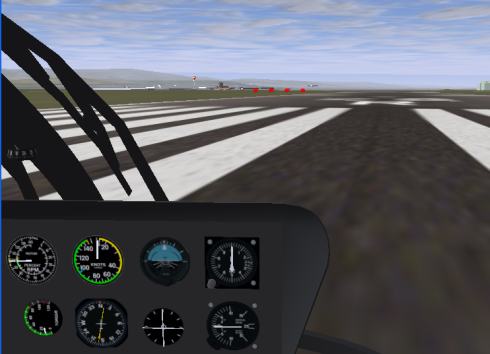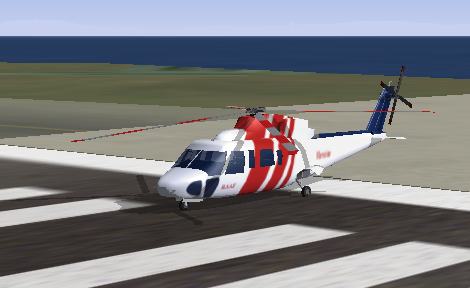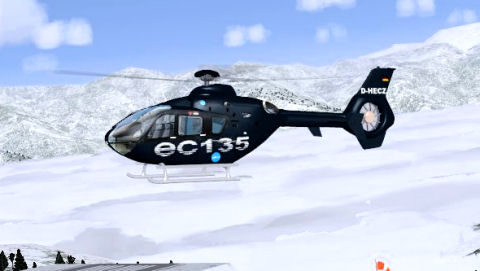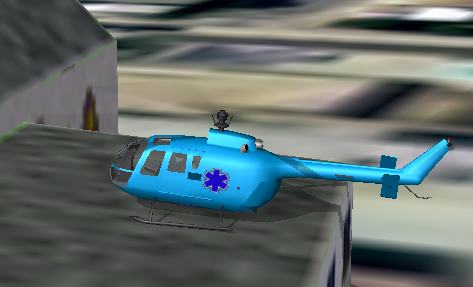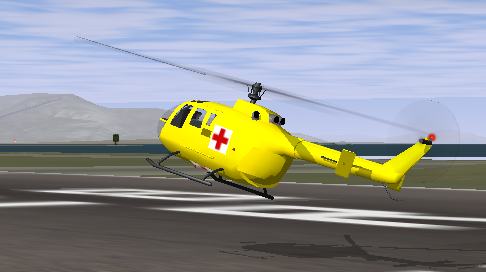Howto:Fly a helicopter
| Note The content of the article was written a long time ago. The concepts of helicopter flight remain valid. Flightgear has changed a lot since that time. There are a lot of new and updated helicopters available through the built-in launcher and from third party hangars |
| Note Some updated helicopters in FGAddon: Alouette-III (AI copilot can assist with takeoff, hovering, and landing. Crash proof.) , Eurocopter EC135 , Eurocopter EC130 B4 (most detailed systems) , Robinson R22 (A small helicopter that is popular for training because it is inexpensive. It is difficult to control, try one of the other helicopters first.) |
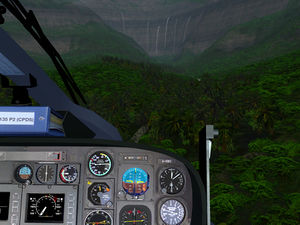
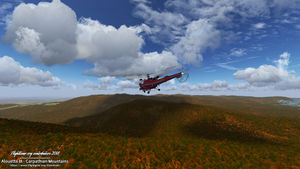
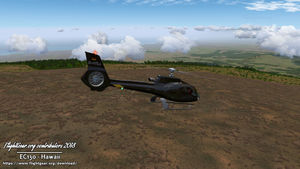
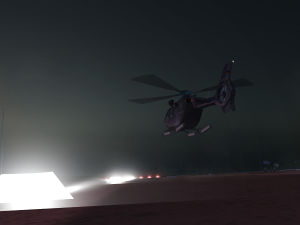
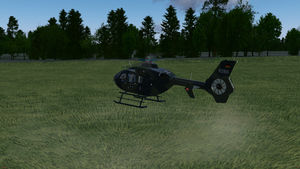
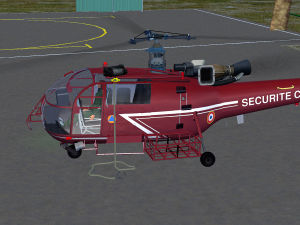
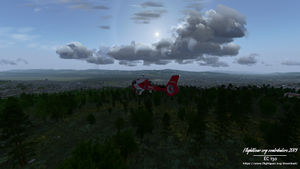
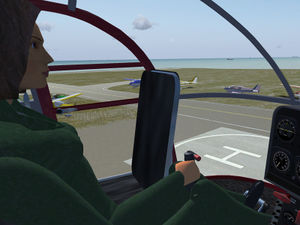
To enable, you have to first select Amelia as crew from the
Alouette-III menu inside the simulator. After selecting start the Alouette-III (can click autostart). After the helicopter has finished starting, you need to ask Amelia to take control from the Alouette-III menu inside simulator. To regain control, hover, or land ask again. To talk to Amelia use
Alouette-III > Amelia > Choose a request > click Ask. The Alouette as of November 2020 is crash proof and will bounce, unlike a lot of helicopters. You can press Ctrl+U to add height if in difficulty - works on a lot of aircraft in FG.Preface
In principle everything that applies to real helicopters, applies also to helicopters in FlightGear. It is important to be familiar with fundamental helicopter manoeuvres. Some details are simplified in FlightGear, in particular the engine handling and some overstresses are not simulated or are without any consequence. In FlightGear it is not possible to damage a helicopter in flight.
Since the release of FlightGear 0.9.10, important improvements have been made to the helicopter flight model. For this reason, version 1.0.0 or later should be used. With these improvements the helicopter flight model of FlightGear should be quite realistic. A notable exception is “vortex ring conditions”. These occur if you descend too fast and perpendicularly (without forward speed). The heli can get into its own rotor downwash causing the lift to be substantially reduced. Recovering from this condition is possible only at higher altitudes. There is video of a Sea King helicopter which got into this condition during a flight demonstration and touched down so hard afterwards that it was completely destroyed.
Control hardware
Stick and Pitch control
On the hardware side a use of a good joystick is recommended:A joystick without centering springs is recommended for cyclic control. You can achieve this with a normal joystick by removing or disabling the centring spring(s), or you could use a force feedback joystick with a disconnected voltage supply. Further, the joystick should have a “thrust controller” (throttle).
Tail rotor controls
For controlling the tail rotor you should have pedals, or at least a joystick that can twist in in a yawing motion. You may have to turn off auto-coordination, as you need full controls for the tail rotor. This can be done by adding the flag --enable-auto-coordination in either the FlightGear Qt launcher or the command line
Joystick
While a joystick feels more natural, it won't have the same deflections like a real heli stick. In most cases it is even less, which makes the heli in FlightGear more difficult to control than the real thing. Usually the full control travel way of a real helicopter stick is between 6 inches and 11 inches depending on the helicopter. The deflections of a real heli stick can be also asymmetrical depending on the helicopter, while our joysticks always have symmetrical deflections.
Mouse
A mouse can be also used, Joystick and mouse has both advantages and disadvantages. The mouse won't feel natural, but you can change the control travel in mice.xml to your need. By decreasing the <factor> you can increase the control travel way and having less sensitive controls, which might improve the handling.
Keyboard
Flying helicopters by keyboard is not possible, as it won't provide sensitive enough control!
Getting started
Launch
The number of available helicopters in FlightGear is increasing rather quickly. As helicopters have become more popular in FlightGear, many others have been developed. Each of them have their unique flight behaviour.
In my opinion the Bo105 is the easiest to fly, since it reacts substantially more directly than other helicopters. The Bell UH-1 is also recommended, though behaving completely different as the Bo105. Nevertheless both models shows very realistic handling qualities, are tested by their real pilots, and their real counterparts are used in some armies for training of pilot novices. The Robinson R44, is also very easy to fly, although possibly unrealistically so.
Once you have loaded FlightGear, take a moment to centralize the controls by moving them around. However, as noted below, the throttle should be at maximum to equal the same as low throttle.
Controls
The helicopter is controlled by four functions. The stick controls two of them, the inclination of the rotor disc (and thus the inclination of the helicopter) to the right/left and forwards/back. Together these functions are called cyclic blade control. Next there is the collective blade control, which is controlled by the thrust controller. This causes a change of the thrust produced by the rotor. Since the powering of the main rotor transfers torque (as a twisting or turning force) to the fuselage, this must be compensated by the tail rotor. Since the torque is dependent on the collective and on the flight condition as well as wind can add additional torque on the fuselage, the tail rotor is also controlled by the pilot using the pedals. If you push the right pedal, the helicopter turns to the right. The pedals are not a steering wheel. Using the pedals you can yaw helicopter around the vertical axis. The number of revolutions of the rotor is kept constant (if possible) by the aircraft.
Behavior of helicopters
Helicopters are natural unstable. It is like balancing a ball sitting on another bigger ball, which is sitting on a much bigger ball. Every control input leads to another control input to compensate: So if you increase the collective, you have to push the pedals to compensate the torque. With this you are increasing the tail rotor thrust and the helicopter wants to drift to the side. So you have to compensate this with the stick...And so on, and so on.
This makes helicopter flying much more difficult than fixed-wings. But with some practice it will become as easy as riding a bicycle!
Lift-Off
| Note Increasing the throttle (pushing the throttle forward) will cause the helicopter to go down, not up. Likewise, decreasing the throttle (pulling back on the throttle) will cause the helicopter to go up. |
First reduce the collective to minimum. To increase the rotor thrust, you have to “pull” the collective. Therefore for minimum collective you have to push the control down (that is the full acceleration position of the thrust controller). Equally, “full power” has the thrust controller at idle. Started the engine by pressing }. After few seconds the rotor will start to turn and accelerates slowly. Keep the stick and the pedals approximately entered. Wait until the rotor has finished accelerating. For the Bo105 there is an instruments for engine and rotor speed on the left of the upper row. The RPM percentage of the rotor should be at 97-100%.
Once rotor acceleration is complete, pull the collective very slowly. Keep your eye on the horizon. If the heli tilts or turns even slightly, stop increasing the collective and correct the position/movement with stick and pedals. If you are successful, continue pulling the collective (slowly!).
As the helicopter takes off, increase the collective a little bit more and try to keep the helicopter in a levelled position. The main challenge is reacting to the inadvertent rotating motion of the helicopter with the correct control inputs. Only three things can help you: practice, practice and practice. It is quite common for it to take hours of practice to achieve a halfway good looking hovering flight. It should be noted that the stick position in a stable hover is not the centre position of the joystick.
Quick Reference:
- Press } to start the turbines; use Automatic startup from the aircraft menu or follow the specific startup tutorial, depending on the helicopter.
- Disengage parking or rotor brake. (If applicable)
- Wait for your turbine to come to full speed
- Push the throttle down, not up. Pushing up makes the chopper go down.
- When at desired altitude, push throttle to about 60%
- Fly freely
| Note Making small inputs will lead you to success! Most helicopters are controlled just by small inputs by the fingers or the hand, the forearm resting on the thigh. |
Video: Takeoff to Hover
The following video is showing a takeoff into hover. The HUD will give you an impression of the needed position of your controls.
A 2nd youtube video showing how to takeoff. There is a simple explanation in the English voiceover, so remember turn your speakers/sound on. View the video on youtube's site here, and press the "CC" button at the bottom of the video on the to get youtube's automatic caption text for the voiceover, which may help non-English speakers.
In the air
To avoid the continual frustration of trying to achieve level flight, you may want to try forward flight. After take off continue pulling the collective a short time and then lower the nose a slightly using the control stick. The helicopter will accelerate forward. With forward speed the tail rotor does not have to be controlled as precisely due to the relative wind coming from directly ahead. Altogether the flight behaviour in forward flight is quite similar to that of a badly trimmed airplane. The “neutral” position of the stick will depend upon airspeed and collective.
Transitioning from forward flight to hovering is easiest if you reduce speed slowly by raising the nose of the helicopter. At the same time, reduce the collective to stop the helicopter from climbing. As the helicopter slows, “translation lift” is reduced, and you will have to compensate by pulling the collective. When the speed is nearly zero, lower the nose to the position it was when hovering. Otherwise the helicopter will accelerate backwards!
You may wonder about that the heli banking to the side. Don't worry, thats normal for helicopters. Due to the thrust of the tail rotor and the fins which also prevents the effect of the main rotor torque, the helicopter is pushed to one side. The helicopter would drift laterally. So to keep the heli straight you have to counteract this effect. That means you have to steer the helicopter so that you don't drift away- so bank the heli against the drift. The more tail rotor thrust you give, the more banking you will have. As an example while hovering. In cruise the fins will take over more and more the work of the tail rotor and will produce the same effect. The side of the banking depends on the direction of turn of the main rotor: Counterclockwise --> left banking. Clockwise --> right banking. That's the reason why on modern helicopters like the EC135 the attitude indicator is even mounted with a bank on the panel.
Video: Hover to Departure
The following video is showing the transition from hover to forward flight. The HUD will give you an impression of the needed position of your controls.
Video: Demonstration of the Effective Translational Lift (ETL)
The following video demonstrates the ETL, or also called translational lift effect. The lift of the rotor will increase by passing a certain relative airspeed, usually about 20ktn. This will led to pitching up the nose while passing this airspeed. This effect is shown here by keeping the collective untouched. You can see how the helicopter behaves at different airspeeds.
Video: Hover Turns
The following video shows how to turn the helicopter in a hover about a spot. This is quite difficult, as the helicopter tends to drift to the side due the tail rotor thrust. Not only that, the tail rotor is "stealing" power from or "giving" power to the main rotor. If you turn to the right with the BO 105 the helicopter will descend, turning to the left it will climb.
Back to Earth I
To land the helicopter transition to a hover as described above while reducing the altitude using the collective. Briefly before hitting the ground reduce the rate of descent slowly. A perfect landing is achieved if you managed to zero the altitude, speed and descent rate at the same time (gently). However, such landing are extremely difficult. Most pilots perform a hover more or less near to the ground and then decent slowly to the ground. Landing with forward velocity is easier, however you must make sure you don't land with any lateral (sideways) component to avoid a rollover.
Quick Reference
- Get to the airport
- Throttle up slowly to about 80%
- Keep it level
- Don't come down too hard
- Land and turn your turbines off by pressing {
Back to Earth II
It is worth mentioning autorotation briefly. This is an unpowered flight condition, where the flow of air through the rotors rotates the rotor itself. At an appropriate altitude select a landing point (at first in the size of a larger airfield) and then switch the engine off by pressing {. Reduce collective to minimum, place the tail rotor to approximately 0 degrees incidence (with the Bo push the right pedal about half , with Russian or French helicopters (like the Alouette 2) the left). Approach at approximately 80 knots. Don't allow the rotor speed to rise more than a few percent over 100%, otherwise the rotor will be damaged (though this is not currently simulated). As you reach the ground, reduce the airspeed by lifting the nose. The descent rate will drop at the same time, so you do not need to pull the collective. It may be the case that the rotor speed rises beyond the permitted range. Counteract this by raising the collective if required. Just above the ground, reduce the descent rate by pulling the collective. The goal is it to touch down with a very low descent rate and no forward speed. With forward speed it is easier, but there is a danger of a roll over if the skids are not aligned parallel to the flight direction. During the approach it is not necessary to adjust the tail rotor, since without power there is almost no torque. If you feel (after some practice), that autorotation is too easy, try it with a more realistic payload via the payload menu.
Not all helicopters will autorotate correctly in Flightgear. Here's a list of those which have been tested (missing rating and difficulty indicates lack of capability):
| Model | Rating | Difficulty | Notes |
|---|---|---|---|
| AH-1 | Good | Medium | It is fairly easy to go into an uncontrolled spin. |
| Bo105 | Good | Medium | |
| EC135 | ? | Easy | |
| Hughes OH-6 Cayuse | Good | Medium | |
| R22 | Bad - Fair | High | Poor tail authority. Compensate by increasing collective. |
| Sikorsky S76C | - | - |
Much fun with the Flightgear helicopters!
The real thing
Watch a pilot flying the real thing from his own perspective. Note the small inputs he is making. Before takeoff the stick is already centered at the needed position, due to the asymmetrical deflection it looks different than in FGFS: https://www.youtube.com/watch?v=HArfICZs5H4
Challenging places to fly
Once you have mastered to take off and land safely, you might want to try more challenging places to take your heli. Here are a few suggestions:
- One of the aircraft carriers
- An oil platform in the North Sea
- After all - who needs a helipad?
